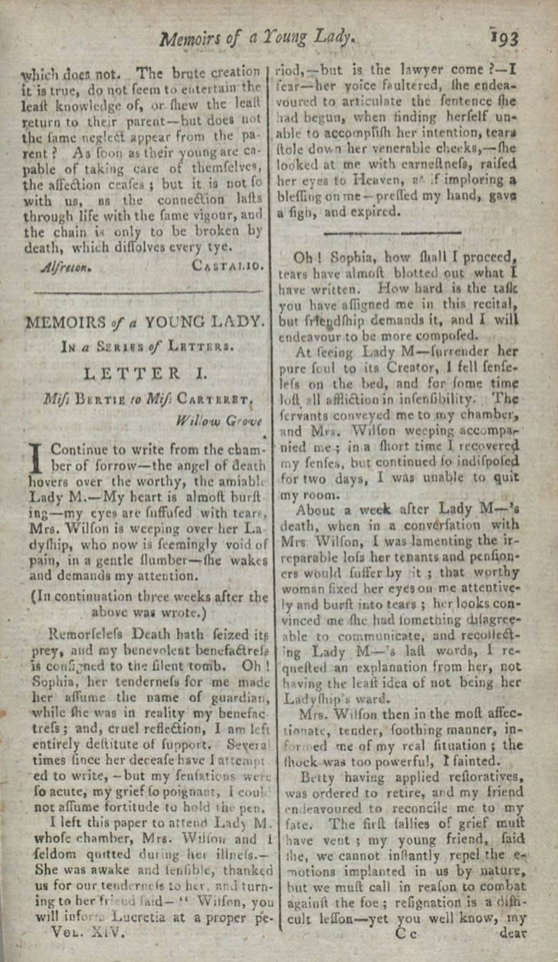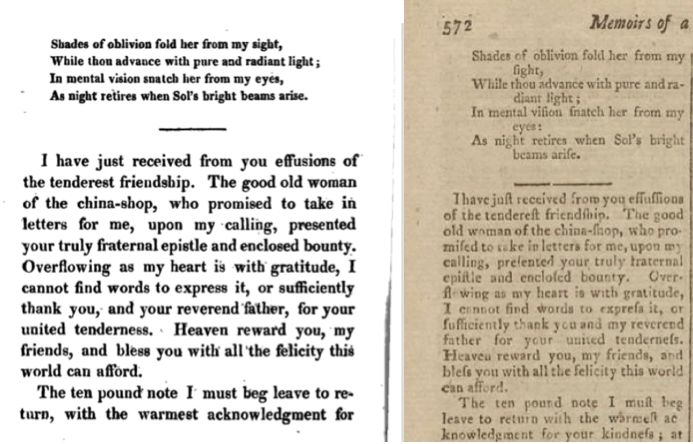The serial fiction in the Lady’s Magazine (1770-1848) is often novel-length, anonymous and absorbing. I began writing this blog about one of the serials that I found particularly engrossing, Memoirs of a Young Lady, intending to point out its originality and praise its writing style and plot. But (perhaps inevitably) as I began researching the serial for the blog in an attempt to uncover any information beyond its publication dates in the magazine, I made a very interesting discovery.
Published from April 1783 through November 1786, the serial entertained readers for over 3.5 years. The anonymous novel, never signed in any of its over 40 installments, has – like most of the fiction in the periodical – remained largely unknown and unstudied.
The novel follows the heroine, Lucretia Bertie, as she navigates her way through the constant persecutions of the primary villain, lord Belton, and his wife, her former friend Sophia. Sophia’s jealousy of Lucretia, inflamed by her husband’s infatuation with the heroine, drives her to devise increasingly vicious plots against her. One of these plots involves hiring her former footman, William, to attempt to force Lucretia into a marriage with him. The footman, posing as a wealthy gentleman, attempts (and fails) to woo Lucretia before threatening her with rape if she refuses to marry him. Sophia justifies her plan in a letter stating that she has paid for a public house for William to run as she does not want to ruin Lucretia’s ‘honour’, but wants to humble her by being a publican’s wife and hopes this will restore her husband’s affection. Lucretia is able to escape the lodgings where she is held captive and flees to safety before further machinations ensue.
The adventures sound, in a simple recitation of the plot points, far-fetched and formulaic. Yet the author ensures this is not the case; such scenes are carefully located within a much longer narrative that frequently focuses on the heroine’s everyday struggles to find gainful employment (at times in a milliner’s shop, at other times as a companion) and to resist her love for a married man, Beaumont (lord Sedley). The epistolary novel is narrated, on the whole, by Lucretia. And while our heroine is certainly virtuous and beautiful, she is also realistic and insightful, equipped with wit and understanding that expose some of the absurdities of the social circle in which she moves.
Searching for traces of an anonymous serial novel is an always time-consuming task but my instinct was that this novel was written by an author who would have kept writing and publishing. After weeks of periodically checking selections of text in various databases a result showed up through Googlebooks. And the result was surprising. The exact same section of the November 1785 installment, word for word, appeared in an 1815 novel by Jane West, Vicissitudes of Life; Exemplified in the Interesting Memoirs of a Young Lady, in a Series of Letters. The novel is mentioned on the Jane West entry on her Orlando page and is cited in The English Novel 1770-1829.[1] The 1815 novel, published anonymously and attributed to Jane West, was printed by J. McCreery in Fleet-Street.
It appears then, although further confirmation is required, that a young Jane West (1758-1852), wrote the novel and published it first as a serial in the Lady’s Magazine from 1783-1787 before publishing it in 1815 in volume form. Jane West, born in London as Jane Iliffe to parents John and Jane Iliffe,[2] moved to Norhamptonshire at age 11 and, according to The Feminist Companion to Literature in English, she was a prolific writer as a teenager.[3] Most of the information available on West is on the Orlando page, which notes that Jane married Thomas West and bore their first child in 1783, the year that the serial novel first began appearing in the Lady’s Magazine. If West was a prolific teenage writer, it is possible that Memoirs of a Young Lady was at least partially written before her marriage, although this is, of course, supposition only. Ten years later West published with the Minerva Press The Advantages of Education, or, The History of Maria Williams. A Tale for Misses and their Mammas (1793) using the pseudonym ‘Prudentia Homespun’ – a pseudonym that does not appear in the Lady’s Magazine. Why West published Memoirs in 1815, and precisely how much of its 1815 content varies from that of its earlier, serialised form, is a subject I am still researching.
Yet even in the early stages of research, such finds are fascinating in the insights they offer us regarding the afterlives of the periodical’s fiction and its correspondents who would later become established writers. It corroborates our understanding of the magazine as medium through which emerging writers could reach a wide audience and view and respond to the reception of their work by the magazine’s readership.
Dr Jenny DiPlacidi
University of Kent
[1] Peter Garside, James Raven and Rainer Schöwerling (eds), The English Novel 1770-1829: A Bibliographical Survey of Prose Fiction Published in the British Isles, 2 vols (Oxford and New York: Oxford University Press, 2000), II: 422.
[2] http://orlando.cambridge.org
[3] Virginia Blain, Patricia Clements and Isobel Grundy (eds), The Feminist Companion to Literature in English: Women Writers from the Middle Ages to the Present (New Haven, CT; London: Yale University Press; Batsford, 1990).
